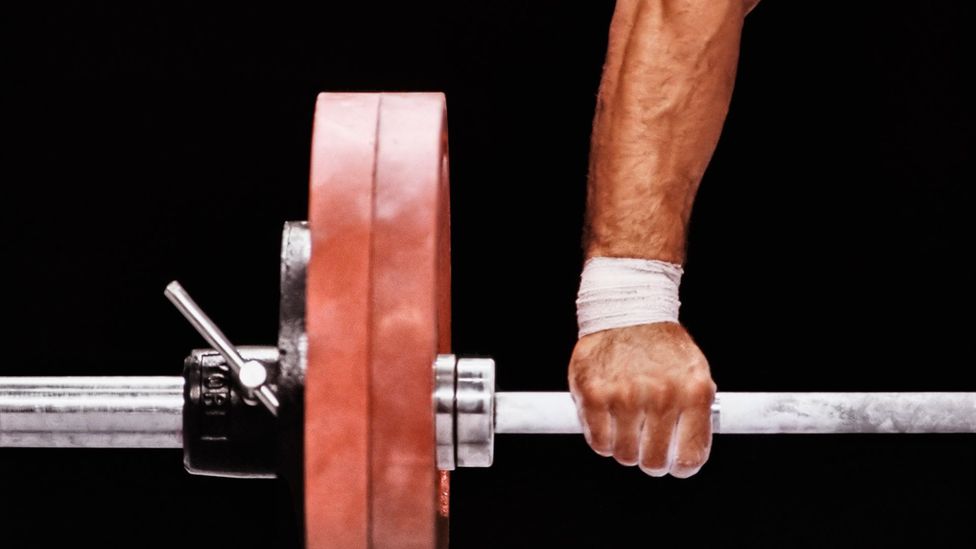Lift Car and Move It Funny
How information technology'south possible for an ordinary person to elevator a motorcar
(Image credit:
Getty Images
)

In a handful of unusual cases, people have tapped into a normally inaccessible super-forcefulness – a hidden Hercules. What'south going on?
I
Information technology'due south a common urban legend: a female parent lifts up a auto to save her screaming kid pinned underneath. And every at present so, this incredible feat of "hysterical strength" seems to actually happen.
In 2012, Lauren Kornacki, a 22-year-old woman in Glen Allen, Virginia, raised a BMW 525i off her father when the automobile toppled from a jack. Seven years before, a human named Tom Boyle hoisted a Chevy Camaro, freeing a trapped cyclist in Tucson, Arizona. The events don't always involve vehicles, like when Lydia Angyiou went toe-to-toe with a polar bear in northern Quebec to protect her son and his friends while they played hockey.
Riveting as these accounts are, scientists have merely a tentative understanding of what exactly might be behind hysterical strength. Later on all, the spontaneous, life-and-expiry situations that apparently unleash it do not lend themselves to rigorous report.
"You tin't really blueprint an experiment to practise this in a lab and brand people think they're going to die," says Due east Paul Zehr, a professor of neuroscience and kinesiology at the Academy of Victoria in British Columbia, Canada. "Something has to happen past fluke."

The world record for deadlifting stands at a mere one,155lbs (524kg) (Credit: Getty Images)
Nevertheless, numerous lines of research, particularly on athletes, have given united states of america compelling insights into the physiological and psychological elements of hysterical strength. "Clearly, nosotros have information technology in u.s.a.," says Robert Girandola, an associate professor of kinesiology at the University of Southern California. "It's not some supernatural forcefulness that'due south causing that force."
Super human being, not superhuman
Before delving further, allow'south establish a central point most hysterical strength: the amounts of mass frequently claimed to be involved in the events are less than reported.
Take the archetypal motorcar-lifting case. A person exhibiting hysterical force is reckoned to have lifted at least 3000lbs (or well-nigh a tonne and a half) – the ballpark weight of a mass-market, non-truck, rider vehicle. This kind of lift is substantially a "dead lift," where someone crouches downward and so lifts an object, similar a barbell with a bunch of weights on it, completely off the flooring.

Urban legends of people picking up cars to save lives accept an chemical element of truth (Credit: Getty Images)
The world record for deadlifting, however, stands at a mere 1,155lbs (524kg), held past Zydrunas Savickas, four-time winner of the Globe'south Strongest Human being competition. Could everyday folk really heft three times the world record?
Probably not. Most reported hysterical strength examples describe a person lifting a portion of a vehicle several inches off the footing, and non an entire automobile. There's the take hold of: three of the vehicle'due south wheels – or maybe even all four, depending on the interruption – remain on the footing, distributing the full weight of the vehicle. Furthermore, a vehicle's mass is not apportioned evenly; the heaviest part is the engine cake, at the front-centre, non at the periphery where the lifting is taking identify.
Put that all together – and not to have away from the backbone of those who have put themselves at gamble to salvage others – but someone in the standard hysterical force scenario is probably lifting more than on the club of several hundred pounds, not an Incredible Hulk-esque few yard.
"You're not lifting the whole car, of class," says Girandola.
More from the muscles
Still, for the vast majority of u.s.a. who aren't natural beefcakes, such a huge deadlift is naught to sneeze at. So how is hysterical strength, even in this more downward-to-World formulation, possible?
I major clue is that we humans are, quite simply, stronger than we realise. Our movements are controlled by the contraction of muscles through signals relayed past nerves. When going about our daily lives, our bodies tend to utilise whatever the to the lowest degree corporeality is of musculus-and-nerve "motor units" to perform an action.

Even elite athletes might only harness around 80% of their theoretical strength (Credit: Getty Images)
"Your muscles are unremarkably activated in a very sure way that'southward really efficient," says Zehr. "Why use your whole muscle mass to elevator up a cup of coffee?"
When nosotros need to lug that burrow up the stairs, we can but recruit more motor units. However fifty-fifty when nosotros feel we are at our limit, nosotros near certainly are not.
Estimates vary, but researchers accept pegged the amount of muscle mass recruited during maximal exercise at around 60%; even elite athletes who have trained to go more than output from their musculature might merely harness effectually 80% of their theoretical forcefulness.
Why practise we keep so much in reserve? Prophylactic, essentially. If we were to exert our muscles to or beyond their accented maximum, we could tear muscle tissue, ligaments, tendons and break bones, leaving usa in dire straits.
"Our brains are ever trying to make sure we don't get pushed likewise far to where we really impairment something," says Zehr. "If yous actually used all the possible force or all the possible energy you could to complete burnout, you'd wind up getting into a situation where you might die."
Hurting and fatigue every bit semi-illusions
To duly disincentivise united states from incapacitating ourselves, we take evolved to feel hurting and distress during periods of loftier exertion. Experiences of those feelings thus dissuade the states from trying to move something that nosotros judge to exist too heavy, like a automobile, under ordinary circumstances.
Though our muscles seem to exist screaming out "stop!", in many cases, we could do more without incurring injury. Until effectually 15 years agone, exercise science had long chalked up muscle fatigue solely to physiological factors inside the muscles themselves. The 1922 Nobel Prize in Physiology winner, AV Hill, established the dogma that the limiting factor in strenuous exercise was simply the body's ability to take in and disseminate free energy-unlocking oxygen to muscles.
This "brainless model," in the words of Timothy Noakes, an emeritus professor in the Segmentation of Exercise Science and Sports Medicine at the University of Cape Town, has withered in recent years. Noakes' work and that of other researchers has reframed the brain not every bit a bystander, but as a "central governor", with primary responsibleness for performance. Per the new thinking, the pain of muscle fatigue is more of an emotion than a reflection of the physical state of exerted muscles in question.

In stressful situations, we ignore the signals that usually stop us causing damage to our bodies (Credit: Getty Images)
Zehr offers a telling chestnut to illustrate the key governor hypothesis. He remembers 30-odd years ago, his martial arts instructor asked the course to practise a leg conditioning stance that really strained the thigh muscles. When the students finally felt they couldn't take the burn anymore and broke their stance, their instructor asked why. "We'd say, 'our legs just gave out' and we'd 'reached our limits'," says Zehr. The teacher responded that if that were so, instead of standing in that location offering excuses, shouldn't Zehr and his fellows have collapsed onto the floor?
The takeaway: our brain, rather than our trunk, largely says when it's time to quit, based on our psychology instead of the physiology of oxygen-starved muscles.
Then what is it psychologically that allows athletes – and for that matter, hysterical strengthers – to overcome their brain's protestations to physical exertion?
Training, which can exist idea every bit frequent exposure to the psychological pain of endeavour, certainly helps in getting ane accustomed to and "pushing through" the agony. There might besides be an underlying genetic component to the subjective feeling of pain, so some people accept a harder time getting as close to their theoretical maximum output, says Zehr. Truly elite athletes might have a built-in advantage of being physiologically predisposed to superior functioning. Either way, it'southward petty surprise that, in studies, highly trained triathletes accept reported college pain thresholds than average folk.
A hard-to-summate, merely titanic cistron behind hysterical forcefulness is, of form, motivation. "We can strength ourselves to ignore some of those pain signals," says Zehr.

We humans are, quite but, stronger than nosotros realise - and that makes lifting parts of cars possible (Credit: Getty Images)
Equally strong equally the motivation might exist for succeeding in an able-bodied competition, the motivation can be arguably mightier for someone direct experiencing danger, or empathising with another in harm'southward fashion. "If you're in a situation where it'due south all risk, and the reward is that you live, you're going to run a risk everything," says Zehr. "There is no adjacent step unless y'all do that."
"We always act with reserve but that control can be overridden," agrees Cape Town'due south Noakes. "I am enlightened of people doing remarkable feats in state of war when if they were defenseless, they would be killed. They have run for days without nutrient or drink."
Adrenaline rush
A key actor in pushing the trunk to extremes is the well-known "adrenaline rush," where hormones such as epinephrine (aka adrenaline) surge out of our adrenal glands, into our blood and throughout the body.
"The release of adrenaline is rapid – seemingly instantaneous – and then that we can respond accordingly to fight-or-flying situations," says Gordon Lynch, a physiologist at the Academy of Melbourne, Australia.
Physiologically, adrenaline boosts animate and heart rate, flooding our muscles with actress, oxygenated blood for more forceful contractions. Fretfulness from the spinal cord running to our bodies' muscles are more than easily able to recruit motor units, again harnessing more of a musculus's total strength. "The more motor units that are recruited, the greater the force that can be developed," says Lynch.
Furthermore, during a stressful, adrenaline-fueled situation, the body's hurting sensitivity seems to fall, as suggested past numerous anecdotes of injuries incurred and simply later fathomed. For example, according to the writer Jeff Wise, simply upon returning domicile from having lifted a car off of a teenager, Boyle – the Arizonian human – felt hurting in his rima oris. Information technology turned out he had unknowingly cracked eight of his teeth, plain from clenching his jaw during the intense lift.

We may all have the strength inside us, but only very specific situations will bring it out (Credit: Getty Images)
The behaviour of people on certain drugs also sheds lite on this pain-and-strength nexus. Users of methamphetamine, cocaine and PCP, just to proper noun a few, have reduced hurting sensitivity due to the pharmacokinetics of the substances. That fact likely explains the seemingly exaggerated forcefulness some users display in violent encounters with police force enforcement. "Drugs can edgeless the pain signals and make you 'superhuman'," says Girandola.
The strength increase from an adrenaline blitz is unquantified, but for an estimate, Girandola points to a study from 1961. Michio Ikai of the Academy of Tokyo and Arthur Steinhaus of George Williams Higher investigated how subjects' grip strengths changed, given sure, ahem, provocations.
"What Ikai did was, he went behind the [study subjects] with a starter pistol," says Girandola, "and he fired it – non at their head – and subsequently the audio, their forcefulness went upward dramatically." By 10%, really, in part based on an adrenaline rush, he says. (Speaking even more assuredly to the reserve vim in our muscles, shouting or grunting by the participants in the 1961 study unlocked 15% more strength, and hypnosis an amazing thirty%.)
Conspicuously, we are capable of more nosotros realise. That truthful capacity may well sally when the stakes are at their highest – or information technology may not.
"We may think we'd know how we'd react nether such stressful situations," says Lynch, "merely we could exist surprised or disappointed."
--
Join 600,000+ Futurity fans by liking united states on Facebook , or follow us on Twitter , Google+ , LinkedIn and Instagram .
If y'all liked this story, sign upward for the weekly bbc.com features newsletter , called "If You Only Read 6 Things This Week". A handpicked choice of stories from BBC Futurity, Earth, Culture, Capital, Travel and Autos, delivered to your inbox every Friday.
gallimorewhady1972.blogspot.com
Source: https://www.bbc.com/future/article/20160501-how-its-possible-for-an-ordinary-person-to-lift-a-car
0 Response to "Lift Car and Move It Funny"
Post a Comment